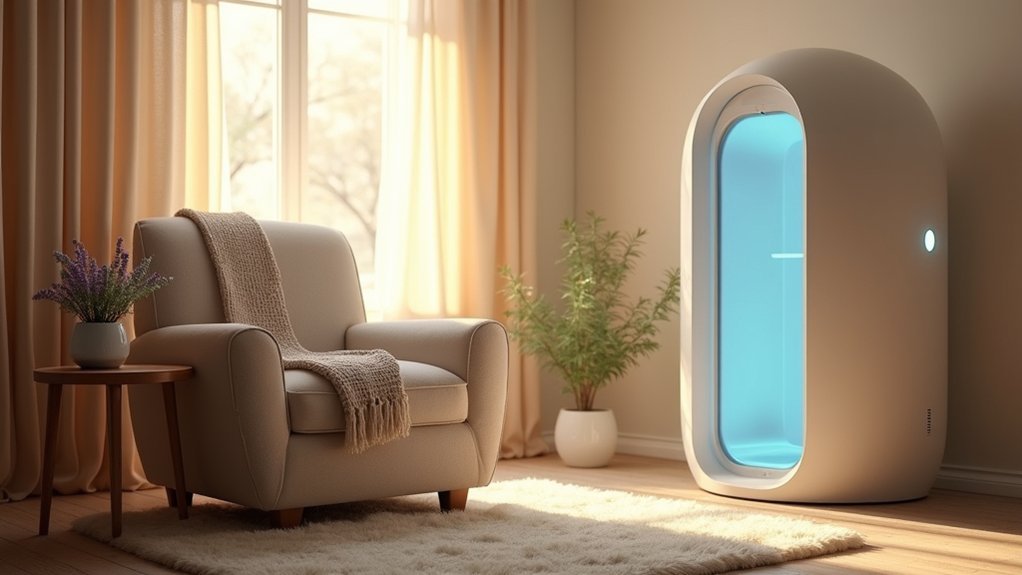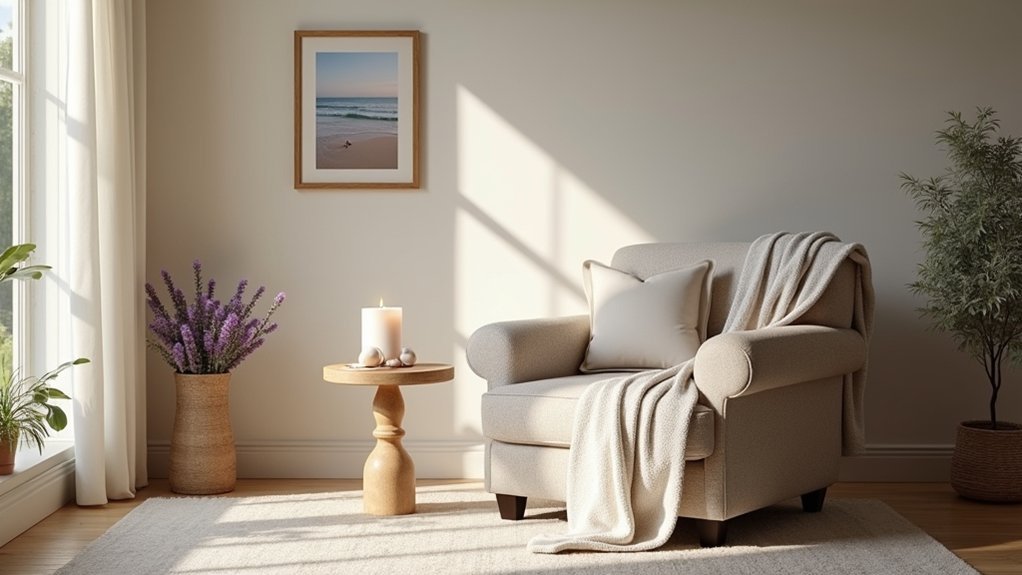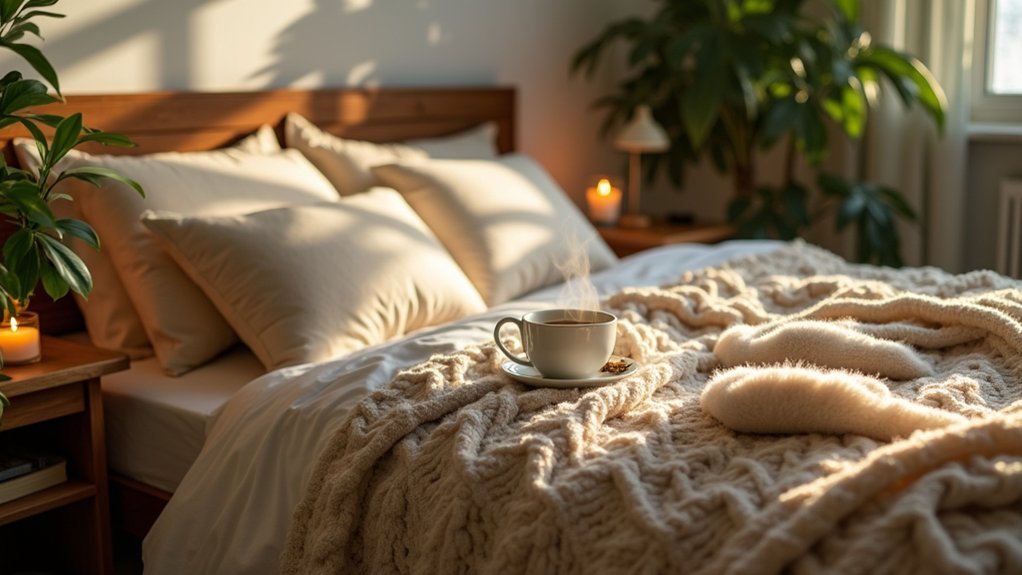You can considerably reduce anxiety by adjusting your environment’s comfort settings to work with your body’s natural responses. Start with customizable field of view adjustments—narrower views provide focused calm while reducing overwhelm. Create safe spaces with warm lighting, soft textures, and familiar scents. Maintain audio at 60-70 decibels using nature sounds or binaural beats. Practice quick relief techniques like 5-4-3-2-1 grounding and diaphragmatic breathing. These foundational adjustments reveal deeper anxiety management strategies.
Motion Sickness Prevention Controls

When motion sickness strikes, it’s often because your eyes and inner ear are sending conflicting signals to your brain about movement and balance. You can take control by focusing on stable objects in the distance, which helps align these conflicting inputs and reduce stress on your nervous system.
Position yourself strategically—sit in the front seat of vehicles or choose midship cabins on boats to minimize motion exposure. Guarantee proper ventilation and fresh air circulation, as these greatly reduce nausea symptoms.
Consider natural remedies like ginger or peppermint before traveling. These anti-nausea properties work effectively to prevent motion sickness symptoms before they develop.
Customizable Field of View Adjustments
Building on physical comfort strategies, your visual environment plays an equally important role in managing anxiety levels. Customizable field of view adjustments give you control over your visual perspective, creating security and comfort in virtual environments. You can tailor settings to minimize distractions and focus on calming elements, which help manage stress responses effectively.
| Setting | Narrow FOV | Wide FOV |
|---|---|---|
| Immersion Level | Focused, intimate | Expansive, open |
| Anxiety Impact | Reduces overwhelm | May increase stimulation |
| Best For | High anxiety moments | Gradual exposure therapy |
| Visual Control | Maximum stability | Enhanced peripheral awareness |
Research shows personalized visual settings improve emotional regulation, helping you cope with anxiety-inducing stimuli. Virtual reality therapy applications use these adjustments to create controlled environments for effective anxiety management.
Teleportation Movement Options

While visual field adjustments create spatial comfort, teleportation movement options offer you a powerful escape mechanism when anxiety peaks.
These visualization techniques let you mentally transport yourself to calming environments, triggering genuine relaxation responses in your body. You’ll engage all your senses through guided imagery, creating vivid mental escapes that reduce perceived stress levels effectively.
When you practice teleportation movement options regularly, you’re developing essential skills for mental health management. This mindfulness technique improves your focus and emotional regulation while fostering control over anxious thoughts.
- Picture yourself on a sun-warmed beach with gentle waves lapping the shore
- Visualize walking through a peaceful forest with sunlight filtering through leaves
- Imagine sitting beside a crackling fireplace in a cozy cabin
- Transport to a serene mountain meadow filled with wildflowers
- Envision floating weightlessly in warm, healing waters
Safe Space Environment Selection
You’ll want to carefully select a sanctuary space that naturally draws you in and feels inherently calming.
The lighting and colors you choose can dramatically shift your mood, so consider how soft, warm illumination and tranquil blues or greens affect your stress levels.
Bringing in natural elements like plants, stones, or wooden textures can further enhance your space’s ability to ground you during anxious moments.
Choosing Your Sanctuary Space
The sanctuary space you create becomes your personal refuge from anxiety’s overwhelming grip.
You’ll want to identify an area that naturally evokes safety and comfort, helping calm your mind when stress peaks. This designated spot should incorporate elements that speak directly to your senses and personal preferences.
Consider these essential elements when designing your sanctuary space:
- Soft textures like plush blankets, velvet cushions, or fuzzy throws that invite touch
- Warm, golden lighting from table lamps or string lights creating gentle shadows
- Personal photographs displaying loved ones’ smiling faces on nearby surfaces
- Familiar scents wafting from lavender candles or eucalyptus diffusers
- Dedicated corners for reading nooks with favorite books or meditation cushions
Personalizing your space with these resonant elements transforms any area into a powerful anxiety-relief haven.
Lighting and Color Impact
How profoundly can the right lighting and colors transform your anxiety levels? The answer lies in understanding their psychological impact on your nervous system.
Soft, warm lighting creates a calming atmosphere by lowering cortisol levels, directly reducing stress responses. You’ll find that dim lighting also stimulates melatonin production, improving sleep quality and enhancing anxiety relief.
Colors play an equally important role in your comfort space. Blue and green tones promote tranquility and reduce anxious feelings, making them perfect choices for your sanctuary.
Don’t underestimate natural light’s power—it improves mood and decreases stress considerably. When you personalize your space with these soothing colors and appropriate lighting, you’re creating an environment that enhances safety and comfort, making it easier to unwind effectively.
Natural Elements Integration
Building on the foundation of soothing colors and lighting, nature’s own elements can amplify your space’s anxiety-reducing power even further.
Integrating natural elements into your environment creates a direct connection to the outdoors, triggering your body’s natural relaxation response. Research shows that even indoor exposure to nature lowers cortisol levels and reduces stress, making these additions essential for anxiety relief.
Transform your space with these calming natural elements:
- Live plants like snake plants or pothos that purify air while adding vibrant greenery
- Small water features such as tabletop fountains that provide soothing sounds
- Natural wood furniture or accents that bring warmth and organic texture
- Stone elements like river rocks or crystals for grounding energy
- Natural fiber textiles including cotton throws or jute rugs for tactile comfort
Audio Volume and Spatial Settings
You can markedly reduce anxiety by controlling your audio environment’s volume and spatial arrangement.
Keep background sounds between 60-70 decibels and use sound isolation techniques like soft furnishings or white noise to block distracting external noises.
Creating the right acoustic atmosphere involves strategically positioning furniture and incorporating calming soundscapes that promote relaxation throughout your space.
Optimal Volume Levels
When you’re setting up your anxiety relief space, the volume levels of your audio environment can make or break your relaxation efforts.
Research shows that ideal volume levels between 60-70 decibels create the perfect backdrop for anxiety relief, mimicking a quiet conversation’s gentle tone. This moderate range helps reduce stress hormones while promoting calm focus.
You’ll want to customize your audio settings based on personal preferences, as this personalization enhances feelings of safety and comfort.
Avoid overly loud environments that can spike anxiety levels and instead create a soothing atmosphere.
- Soft rainfall pattering against windows at conversation-level volume
- Gentle ocean waves lapping the shore in the distance
- Quiet instrumental music flowing like a whispered melody
- Birds chirping softly in a peaceful morning garden
- White noise humming like a distant, comforting breeze
Sound Isolation Techniques
Sound isolation transforms your carefully calibrated volume levels into an even more powerful anxiety-relief tool by eliminating unwanted noise intrusions.
You’ll find that soundproofing materials like acoustic panels or heavy curtains can reduce ambient noise by up to 50%, creating the perfect foundation for relaxation practices.
Designating quiet zones in your space encourages mindfulness and meditation while providing a peaceful retreat from overwhelming stimuli.
When external sounds can’t penetrate your environment, your stress response naturally decreases, allowing you to focus on calming activities.
Consider adding white noise machines or nature sounds at moderate volumes to mask any remaining disturbances.
These gentle audio layers create a protective sound barrier that promotes feelings of safety and security, helping you relax more deeply in your specially crafted sanctuary.
Relaxing Audio Environments
Beyond achieving isolation from disruptive noise, creating the ideal relaxing audio environment requires careful attention to both volume levels and spatial acoustics.
You’ll want to maintain audio at approximately 60 decibels—similar to quiet conversation volume—to promote calmness without overwhelm. Good acoustics enhance sound clarity, making relaxing audio environments more effective for therapeutic purposes.
Consider incorporating binaural beats, which use slightly different frequencies in each ear to foster meditation and reduce anxiety.
Establish a dedicated listening space free from distractions to maximize therapeutic benefits.
- Soft rainfall pattering against windows while you’re nestled in cushions
- Gentle ocean waves rhythmically washing ashore in twilight
- Whispering wind through tall forest trees on peaceful afternoons
- Warm instrumental melodies floating through acoustically-treated rooms
- Synchronized breathing with binaural frequencies in your sanctuary space
Visual Brightness and Contrast Controls
How often do you find yourself squinting at your screen or feeling overwhelmed by harsh lighting? Adjusting your visual brightness and contrast controls can greatly reduce eye strain and improve your mental health.
Lowering screen brightness minimizes glare and prevents overstimulation, creating a calmer viewing experience that reduces stress levels.
High contrast settings enhance readability while reducing cognitive load, making content easier to process without feeling overwhelmed.
You’ll find it particularly helpful to use blue light filters during evening hours, as they promote better sleep quality by protecting your natural circadian rhythms.
Regularly adjusting these visual settings based on your surrounding ambient light helps maintain a comfortable environment, reducing distractions and promoting an overall sense of calm.
Emergency Exit and Pause Functions

When anxiety hits hard, you need quick relief techniques that work like an emergency brake for your racing mind.
These immediate stress stoppers give you the power to pause overwhelming moments and regain control before panic takes over.
Think of them as your anxiety’s off switch—simple tools you can activate anywhere, anytime to create instant breathing room.
Quick Relief Techniques
Since anxiety can strike without warning, having quick relief techniques ready acts like an emergency exit button for your mind. These immediate interventions help you manage stress when overwhelming feelings threaten to take control.
Quick Relief Techniques:
- 5-4-3-2-1 Grounding: Identify 5 things you see, 4 you can touch, 3 you hear, 2 you smell, and 1 you taste.
- Diaphragmatic Breathing: Breathe deeply through your nose, hold briefly, then exhale slowly through pursed lips.
- Gentle Stretching: Roll your shoulders, stretch your neck, or do simple arm movements to release tension.
- Mental Escape Visualization: Picture yourself in a peaceful place like a quiet beach or cozy cabin.
- Language Switching: Count in another language or play calming music to redirect your anxious thoughts.
Immediate Stress Stoppers
Every second counts when anxiety peaks, and immediate stress stoppers function as your mental circuit breakers—powerful interventions that halt escalating panic before it overwhelms your system.
Deep breathing exercises engage your parasympathetic nervous system, effectively lowering heart rate while promoting instant relaxation. Focus on diaphragmatic breathing—slow, deliberate inhales that signal safety to your body and help reduce physiological stress symptoms.
Try the 5-4-3-2-1 grounding technique: identify five things you see, four you can touch, three you hear, two you smell, and one you taste. This redirects attention from anxious thoughts to present-moment awareness.
Simple neck and shoulder stretches release muscle tension while calming your mind. Guided imagery offers mental escape through visualizing peaceful scenes, engaging multiple senses to lower anxiety levels immediately.
Personal Boundary Establishment Tools
The foundation of anxiety relief often rests on your ability to establish clear personal boundaries that protect your mental space and energy. When you set firm limits, you’ll notice reduced stress and anxiety levels while preventing burnout.
Learning to say no becomes your superpower—those who struggle with this skill often experience heightened anxiety. You need to identify your core values and priorities first, then communicate these boundaries assertively to improve your relationships through mutual respect.
Essential boundary-setting tools include:
- The Values Compass – Creating a written list of your non-negotiables
- The Energy Audit – Tracking what drains versus energizes you daily
- The Script Collection – Preparing phrases for common boundary situations
- The Check-In Calendar – Scheduling monthly boundary reassessments
- The Support Network – Identifying allies who respect your limits
Haptic Feedback Intensity Management
While establishing mental boundaries creates the framework for anxiety management, fine-tuning your device’s haptic feedback intensity can provide immediate, tangible comfort when stress peaks.
When you’re feeling anxious, customized haptic settings can mimic soothing physical touch, triggering your body’s natural calming response. You’ll find that personalized intensity levels work better than default settings, as they align with your specific comfort preferences.
Optimized haptic feedback can help ground you during overwhelming moments by redirecting your focus from anxious thoughts to present-moment tactile sensations.
This redirection improves concentration and reduces stress in high-pressure situations. The gentle vibrations or pulses serve as mindfulness anchors, pulling your attention away from spiraling worries.
Session Duration and Break Reminders
Beyond customizing your device’s physical responses to stress, managing your activity timeframes creates another layer of anxiety prevention.
Setting your session duration to 25-30 minutes using the Pomodoro Technique maintains concentration while reducing anxiety levels. You’ll find that incorporating 5-minute break reminders after each focused session allows mental rejuvenation and prevents burnout.
Configure your digital calendar or productivity apps to send automatic break reminders at regular intervals. This promotes consistent rest periods that reduce stress accumulation throughout your day.
- Timer notifications gently chiming as your 25-minute writing session concludes
- Phone buzzing softly, signaling time to step away from spreadsheets
- Calendar pop-ups appearing like friendly taps on your shoulder
- Desktop alerts glowing warmly, inviting you to stretch and breathe
- App notifications creating gentle pauses in your focused workflow
Frequently Asked Questions
What Is the 3 3 3 Rule for Anxiety?
The 3 3 3 rule helps you ground yourself during anxiety by identifying three things you can see, three things you can hear, and three things you can feel around you.
What Is the Comfort Zone for Anxiety?
Your comfort zone for anxiety is a safe space where you feel secure and in control. It includes familiar environments, calming activities, supportive people, and personal items that reduce stress and promote emotional well-being.
Where Should I Put Essential Oils for Anxiety?
You should place essential oils in diffusers for common areas, apply them to pulse points like wrists and neck, inhale directly from bottles, add to baths, or spray on pillows for anxiety relief.
What Is the 5 5 5 Rule for Anxiety?
You’ll identify five things you can see, five things you can touch, and five things you can hear. This grounding technique helps redirect your focus from anxious thoughts to your immediate environment.





Leave a Reply